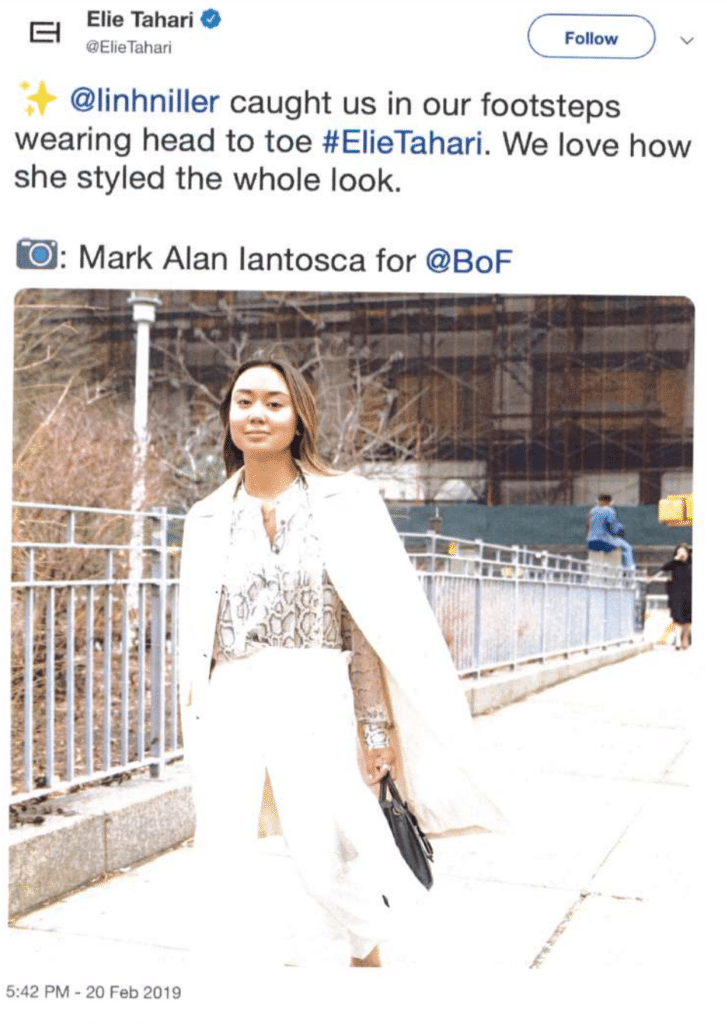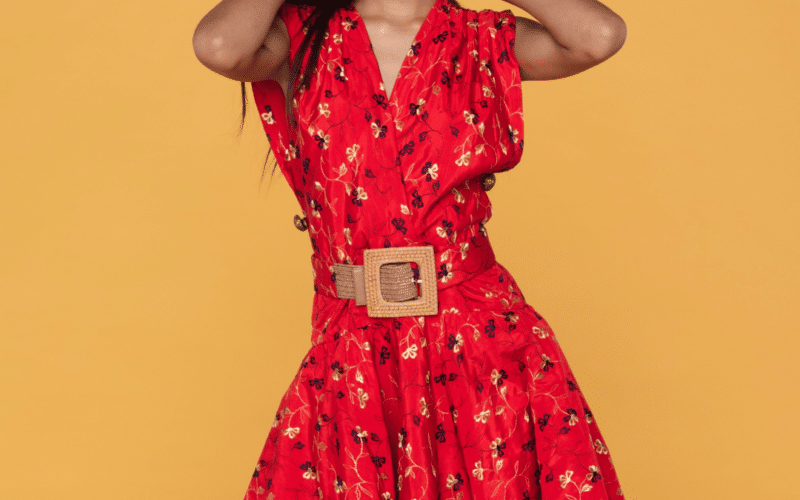Fashion designer Elie Tahari was found liable for copyright infringement after reposting a street style photo of one of its outfits on social media. It’s a common practice, but that doesn’t necessarily mean it’s legal.
“Everybody Else Is Doing It, So Why Can’t We?” That’s great if you’re referring to The Cranberries’ debut album. As a legal defense to copyright infringement, not so much.
Elie Tahari, Ltd. learned that the hard way this week, as a judge in the Southern District of New York found the luxury fashion designer liable for copyright infringement (copy of order here). The court rejected Tahari’s argument that reposting photos on social media has become “commonplace” and is therefore legal, granting a summary judgment motion brought by fashion photographer Mark Iantosca.
The Tahari Lawsuit
The photo at issue was Iantosca’s shot of digital content creator Linh Niller dressed in an Elie Tahari ensemble.

Seizing an opportunity to promote its brand, Tahari posted the photo on its social media accounts. Tahari credited Iantosca as the photographer, but didn’t ask for (or receive) his permission to post the photo.

Iantosca registered the copyright in his photo and hired notorious plaintiffs’ lawyer Richard Liebowitz to file a copyright infringement lawsuit against Tahari.
No Fair Use
Like many defendants who post images on social media that they don’t own, Tahari argued that its reproduction of the photo constituted “fair use” under the Copyright Act. The problem for Tahari was that it wasn’t commenting on the photo, nor was it really even using the photo to comment on a newsworthy event. To the extent Tahari was commenting on anything, it was only to say how good Linh Niller looked wearing its clothes in order to advertise the brand. Because Tahari was making a commercial use of the image in a manner that wasn’t sufficiently “transformative,” the court rejected Tahari’s fair use defense.
The De Minimis Defense
Tahari’s other main defense was a bit more unconventional. The company argued that its use of the photograph was “de minimis,” which basically means “it’s no big deal” in latin. The phrase is actually short for de minimis non curat lex (“The law does not concern itself with trifles.”)
To understand the de minimis defense, just try to think of the most ridiculous lawsuits you can imagine. I’ll help, with some real life examples of our tax dollars at work:
- A high school student was penalized for an unexcused absence with a three point deduction from her six week algebra grade, which dropped her overall GPA from 95.478 to 95.413. Her parents (who amazingly lived in Texas and not West L.A.) brought a federal civil rights lawsuit on the student’s behalf, which the court tossed.
- A defendant was charged with shoplifting three pieces of Bazooka gum valued at 15 cents from a 7-Eleven. Dismissing the case, the court noted that “[i]n the milieu of bubble gum pilferage the only cases more trivial are those involving two pieces or one.”
- After eating at lunch at the Cornucopia Buffet at Atlantic City’s Golden Nugget, a couple decided to take a few pieces of fruit for dessert. The husband was convicted of stealing two bananas, an orange, an apple and a pear and was fined $25. On appeal, the court dismissed the case as de minimis. It even suggested that the “theft” may have been prompted by a buffet employee pressuring the couple to finish their meal, causing the court to remark: “buffet-type restaurants should not be permitted to harass people into leaving before they are ready.”

(For more on these and other great examples of conduct courts have found to be de minimis, check out this law review article by Jeff Nemerofsky.)
The de minimis defense has also been successfully applied to copyright infringement cases, although it’s relatively rare. One example is Gottlieb v. Paramount Pictures, in which the plaintiff’s “Silver Slugger” pinball machine appeared for a few seconds in the background of a scene from the otherwise forgettable Mel Gibson rom-com “What Women Want.” Likewise, in Sandoval v. New Line Cinema, the Second Circuit found that the defendants’ use of ten of the plaintiff’s photos for less than 36 seconds in the film “Seven” was de minimis. And just this year, the court in Solid Oak Sketches v. 2K Games held that the use of NBA players’ tattoos in the popular “NBA 2K” video games was de minimis, pointing out that the tattoos appeared only fleetingly, and comprised only 0.000286% to 0.000431% of the total game data.
The takeaway from these cases is that the use of someone else’s copyrighted work may be de minimis if the work appears only briefly, is obscured, out of focus, or otherwise does not comprise the focal point of the new work in which it appears.
With all this in mind, let’s go back to the Tahari case. Based on the facts, Tahari couldn’t credibly argue that it used Iantosca’s photo in any sort of fleeting manner. The image constituted the entirety of the company’s social media post. Instead, Tahari took the position that its use was de mimimis because reposting photos on social media has become commonplace and, essentially, that “everyone else is doing it.” Not surprisingly, Tahari didn’t get any further with that argument than you did as a teenager.
Giving Credit
Tahari’s final defense was that its use did not constitute copyright infringement because the company credited the photographer Iantosca in its social media posts. That one was DOA too. As we’ve discussed in our Copyright Myth Project, while giving credit is the right thing to do, it won’t legally absolve you of an otherwise valid infringement claim.
So What’s a Brand Owner to Do?
There’s no question that reposting someone else’s photo on social media is very common. There’s also no question that being forced to defend a copyright lawsuit brought by Richard Liebowitz is no fun. Trust me, I’ve been there many times. But until the Southern District of New York officially recognizes “Plaintiff’s counsel is Richard Liebowitz” as a affirmative defense, brand owners need to realize that reposting images carries legal risk.
Given the massive popularity of social media sites like Instagram and Twitter, it’s certainly understandable that brand owners are interested in obtaining the caché and free publicity that comes with reposting images of people wearing or using their products. But regardless of whether a particular photo has been taken by a professional photographer or Joe the Random Consumer, the best practice is always to ask for—and receive—permission from both the photographer and the subject before posting.
Importantly, brands should seek permission even if the photographer posts it first with a tag or hashtag to the product brand. Volvo is currently defending a lawsuit brought by a photographer and a model who claim their test shoot photos were used without permission by Volvo as a social media advertisement. The photographer tagged Volvo when he originally posted his images, but declined the automaker’s request to repost the photos when Volvo refused to pay for a license. While it may be possible to argue that a tag on social media serves as implied consent in certain situations, defending a copyright lawsuit is an expensive way to find out. It’s also possible that the person doing the tagging doesn’t own any rights in the photo, in which case she wouldn’t have the right to consent to your repost in any event.
There are other ways to minimize the chance of liability. I talked in an earlier article about embedding as an alternative to posting. But while embedding is safer, it’s not risk-free.
The good news is that many photographers and models would love the exposure that comes with having their images posted and tagged by a well-known brand. The best way to find out? Just ask them.
As always, I’d love to hear your thoughts. Use the comments below or our socials @copyrightlately






